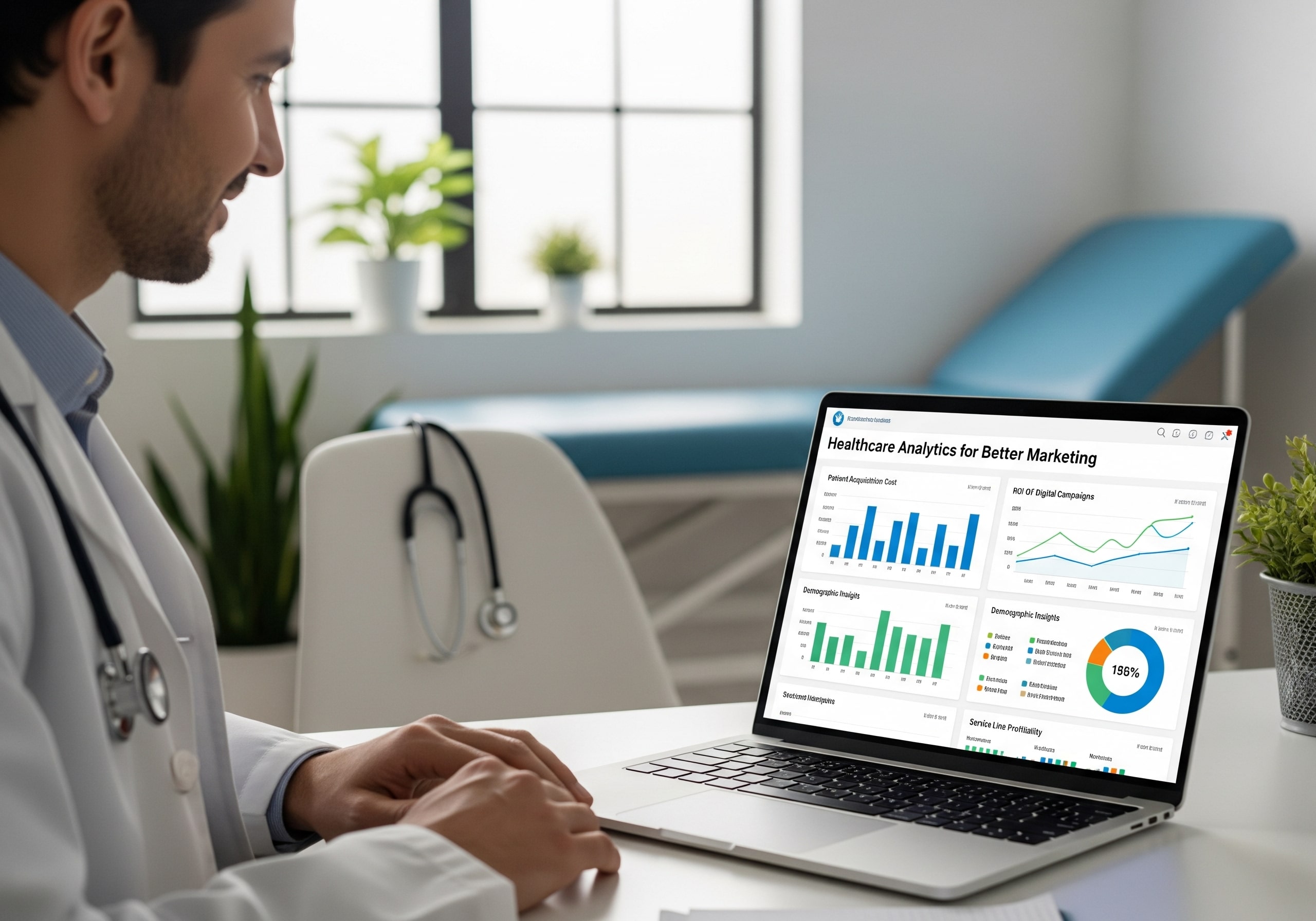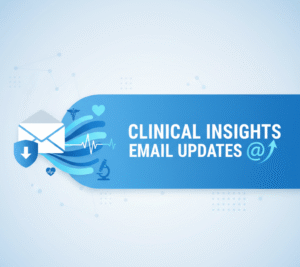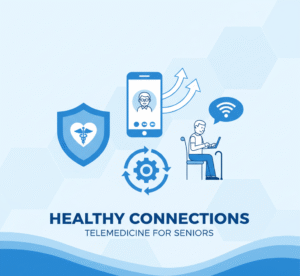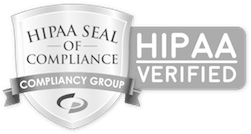“Leverage healthcare analytics for better marketing by tracking key performance indicators (KPIs) to measure campaign ROI, understand patient behavior, and make data-driven decisions.”
In the ever-evolving world of healthcare, marketing has become more than just a means of communication; it’s a critical component of patient acquisition and retention. However, with the plethora of marketing channels and strategies available, how do you know what’s working? The answer lies in tracking the right Key Performance Indicators (KPIs). This comprehensive guide will walk you through the ins and outs of healthcare analytics for better marketing, helping you to select, measure, and optimize the KPIs that matter most to your organization.
The Shifting Sands of Healthcare Marketing
The healthcare industry is undergoing a massive transformation. Patients are no longer passive recipients of care; they are active consumers who research their options, read reviews, and make informed decisions about their health. This shift in patient behavior has forced healthcare organizations to rethink their marketing strategies. Traditional marketing methods, such as print ads and billboards, are no longer as effective as before. Today, a strong digital presence is paramount.
This is where digital marketing for healthcare comes into play. From search engine optimization (SEO) and content marketing to social media and pay-per-click (PPC) advertising, there are countless ways to reach and engage with potential patients online. However, simply launching a digital marketing campaign is not enough. You need to be able to measure its performance and make data-driven decisions to improve your results over time. This is where healthcare marketing KPIs become indispensable.
What Are KPIs and Why Do They Matter in Healthcare Marketing?
A Key Performance Indicator (KPI) measures how effectively a company achieves its key business objectives. In healthcare marketing, KPIs help you understand what’s working and what’s not, so you can allocate your resources more effectively and maximize your return on investment (ROI).
It’s important to distinguish between metrics and KPIs—a metric measures something, such as website traffic or social media followers. A KPI, on the other hand, is a metric that is tied to a specific business goal. For example, if your goal is to increase patient appointments, then the number of online appointment bookings would be a key KPI.
Tracking the right medical marketing metrics is crucial for several reasons:
- It allows you to measure your ROI. By tracking your KPIs, you can see how much revenue your marketing campaigns generate and compare that to your marketing spend. This will help you to justify your marketing budget and make the case for future investment.
- Analyzing your KPIs can help you understand your patients. You can gain valuable insights into their behavior, preferences, and needs, which can be used to create more targeted and effective marketing campaigns.
- It enables you to optimize your campaigns. By monitoring your KPIs in real-time, you can identify areas for improvement and adjust your campaigns on the fly. This will help you to get the most out of your marketing budget and achieve your goals more quickly.
Categorizing Healthcare Marketing KPIs
It’s helpful to categorize your healthcare marketing KPIs into different groups to make sense of the vast data available. Here are four key categories to consider:
- Patient Engagement KPIs: These KPIs measure how well you connect with your target audience and build relationships with them.
- Lead Generation KPIs: These KPIs track your ability to attract potential patients and convert them into leads.
- Conversion KPIs: These KPIs measure your success in turning leads into actual patients.
- ROI and Revenue KPIs: These KPIs demonstrate the financial impact of your marketing efforts.
Let’s take a closer look at each of these categories and the specific KPIs they entail.
A Deep Dive into Key Healthcare Marketing KPIs
Now that you have a general understanding of the different categories of KPIs, let’s explore some of the most critical medical campaign analytics to track.
Patient Engagement KPIs
Patient engagement is the foundation of any successful healthcare marketing strategy. If you’re not connecting with your audience, you won’t be able to generate leads or drive conversions. Here are some of the most critical patient engagement tracking KPIs to monitor:
- Website Traffic: This is one of the most basic yet essential KPIs to track. It tells you how many people are visiting your website, which is often the first point of contact for potential patients. You can track your website traffic using Google Analytics, a free tool that provides a wealth of information about your website’s visitors.
- Bounce Rate: Your bounce rate is the percentage of visitors who leave your website after viewing only one page. A high bounce rate can indicate that your website is not engaging or does not provide the information visitors are looking for. You can reduce bounce rates by improving your website’s design, navigation, and content.
- Average Session Duration: This KPI tells you how long visitors spend on your website. A longer average session duration is generally a good sign, as visitors find your content valuable and engaging.
- Pages per Session: This KPI measures the average number of pages visitors view during a single session. More pages per session suggests visitors are exploring your website and learning more about your organization.
- Social Media Engagement: If you’re active on social media, you’ll want to track your engagement metrics, such as likes, shares, comments, and followers. These metrics can help you understand how well your content resonates with your audience and identify opportunities to improve your social media strategy.
- Email Open and Click-Through Rates: If you’re using email marketing to connect with your patients, you’ll want to track your open and click-through rates. Your open rate is the percentage of people who open your emails, while your click-through rate is the percentage of people who click on a link in your email. These metrics help you gauge the effectiveness of your email campaigns and improve your subject lines, content, and calls to action.
- Video Views and Completion Rates: Video is a powerful tool for engaging with patients, and it’s becoming increasingly popular in healthcare marketing. If you create videos, you’ll want to track your views and completion rates. Your completion rate is the percentage of viewers who watch your video to the end. A high completion rate indicates that your videos are engaging and informative.
Lead Generation KPIs
Once you’ve captured your audience’s attention, the next step is to convert them into leads. A lead is a potential patient who has expressed interest in your services by providing you with their contact information. Here are some of the most critical healthcare lead generation KPIs to track:
- Form Submissions: This is one of the most common ways to generate leads online. By placing forms on your website, you can collect contact information from visitors interested in learning more about your services. You should track the number of form submissions you receive and the conversion rate of each form.
- Phone Calls from Marketing Campaigns: Many patients still prefer to pick up the phone and call a healthcare provider directly. That’s why tracking the number of phone calls you receive from your marketing campaigns is essential. You can use a call tracking service to assign unique phone numbers to your marketing channels to see which channels drive the most calls.
- Newsletter Subscriptions: A newsletter is a great way to stay in touch with potential patients and nurture them until they’re ready to book an appointment. You should track the new subscribers you get each month and your newsletters’ open and click-through rates.
- Downloads of Gated Content: Gated content is any type of content that requires visitors to provide their contact information to access it. This can include ebooks, whitepapers, webinars, and more. By offering valuable gated content, you can generate high-quality leads genuinely interested in what you offer.
- Cost Per Lead (CPL): Your CPL is the money you spend to acquire a single lead. To calculate your CPL, divide your total marketing spend by the number of leads you generated. This KPI is essential for understanding the efficiency of your lead generation efforts and ensuring you’re getting a good return on your investment.
Conversion KPIs
Generating leads is great, but it’s not the end goal. The ultimate goal of any healthcare marketing campaign is to convert leads into actual patients. Here are some of the most critical conversion KPIs to track:
- New Patient Acquisition: This is the most critical conversion KPI of all. It tells you how many new patients you’re acquiring due to your marketing efforts. You can track this KPI by asking new patients how they heard about you or by using a CRM system to track the source of each new patient.
- Appointment Bookings: This KPI is a good indicator of how well you’re converting leads into patients. You can track the number of online appointment bookings you receive and the number of appointments booked over the phone.
- Conversion Rate (from Lead to Patient): Your conversion rate is the percentage of leads who become patients. To calculate your conversion rate, divide the number of new patients by the number of leads you generated. This KPI is a great way to measure the effectiveness of your sales and marketing funnel.
- Cost Per Acquisition (CPA): Your CPA is the money you spend to acquire a single patient. To calculate your CPA, divide your total marketing spend by the number of new patients you acquired. This KPI is essential for understanding your marketing campaigns’ profitability and ensuring you’re not overspending to acquire new patients.
ROI and Revenue KPIs
Your healthcare marketing efforts need to impact your bottom line positively. That’s why tracking your ROI and revenue KPIs is so essential. Here are some of the most important ones to monitor:
- Return on Investment (ROI): Your ROI is the most important financial KPI. It tells you how much revenue you generate for every dollar you spend on marketing. To calculate your ROI, simply subtract your marketing spend from the revenue you generated from your marketing campaigns, and then divide that number by your marketing spend.
- Customer Lifetime Value (CLV): Your CLV is the total revenue a single patient is expected to generate for your organization throughout their lifetime. This KPI is important for understanding the long-term value of your patients and ensuring that you’re investing enough in patient retention.
- Patient Acquisition Cost (PAC): Your PAC is the total cost of acquiring a new patient, including all your sales and marketing expenses. This KPI is important for understanding the profitability of your patient acquisition efforts and ensuring you’re not spending more to acquire a patient than they’re worth.
- Revenue Generated from Marketing Campaigns: This is a straightforward yet essential KPI to track. It tells you how much revenue your marketing campaigns generate for your organization. You can track this KPI using a CRM system to attribute revenue to specific marketing campaigns.
How to Choose the Right KPIs for Your Healthcare Campaign
With so many KPIs to choose from, it can be overwhelming to know where to start. Selecting the most relevant KPIs to your specific marketing goals is key. Here are a few tips for choosing the correct KPI measurement in healthcare:
- Align your KPIs with your goals. Before you start tracking anything, you must clearly understand what you’re trying to achieve with your marketing campaigns. Are you trying to increase brand awareness, generate leads, or drive patient appointments? Once you know your goals, you can select the KPIs that will help you measure your progress.
- Consider your target audience. Who are you trying to reach with your marketing campaigns? What are their needs and preferences? By understanding your target audience, you can select the KPIs that will give you the most insights into their behavior.
- Focus on a manageable number of KPIs. It’s better to track a few key KPIs well than to track a bunch of them poorly. Start with a few KPIs most important to your business, then add more as you get more comfortable with the process.
- Review and adjust your KPIs regularly. Your marketing goals and strategies will change over time, and so should your KPIs. Review your KPIs regularly to ensure they are relevant and aligned with your goals.
Tools and Technologies for Tracking Healthcare Marketing KPIs
Several tools and technologies help you track your healthcare marketing performance. Here are a few of the most popular ones:
- Google Analytics: As mentioned earlier, Google Analytics is a free tool that provides a wealth of information about your website’s visitors. It’s essential for tracking your website traffic, bounce rate, average session duration, and other essential website metrics.
- CRM Systems: A CRM (Customer Relationship Management) system is a software application that helps you manage your interactions with your patients and potential patients. A sound CRM system will allow you to track your leads, conversions, and revenue and provide valuable insights into your patients’ behavior.
- Call Tracking Software: If your marketing campaigns generate a lot of phone calls, you’ll want to use a call tracking service. This service allows you to assign unique phone numbers to each marketing channel to see which channels drive the most calls.
- Social Media Analytics Tools: Most social media platforms have their built-in analytics tools that you can use to track your engagement metrics. There are also several third-party social media analytics tools available that can provide you with more in-depth insights.
- Email Marketing Platforms: If you’re using email marketing, your email marketing platform will provide you with a wealth of data, including your open rates, click-through rates, and conversion rates.
Using these tools and technologies, you can better understand your healthcare data-driven marketing efforts and make more informed decisions about allocating your resources.
The Role of a Specialized Medical Digital Marketing Agency
While tracking your healthcare marketing KPIs is possible, it can be time-consuming and complex. That’s why many healthcare organizations choose to partner with a specialized medical digital marketing agency. A good agency will have the expertise and resources to help you select the right KPIs, set up your tracking systems, and analyze your data.
This is where InvigoMedia comes in. As a leading medical digital marketing service provider, we specialize in helping healthcare organizations achieve measurable growth through targeted KPI tracking and campaign management. Our team of experts deeply understands the healthcare industry and knows what it takes to succeed in today’s competitive market.
When you partner with InvigoMedia, you’ll get:
- A customized marketing strategy. We’ll work with you to develop a marketing strategy tailored to your specific goals and target audience.
- Expert campaign management. We’ll manage all aspects of your marketing campaigns, from content creation and SEO to social media and PPC.
- In-depth KPI tracking and reporting. We’ll track your KPIs regularly and provide you with detailed reports that show you how your campaigns are performing.
- Data-driven optimization. We’ll use our collected data to optimize your campaigns and continuously improve your results.
With InvigoMedia as your partner, you can be confident that your marketing dollars are well-spent and that you’re on the right track to achieving your business objectives.
Conclusion
In today’s data-driven world, tracking the right healthcare marketing KPIs is no longer an option; it’s necessary. By carefully selecting, measuring, and optimizing your KPIs, you can gain a deeper understanding of your patients, improve the performance of your marketing campaigns, and ultimately, achieve your business goals.
If you’re ready to take your healthcare marketing to the next level, we encourage you to contact InvigoMedia today. Our expert team will happily answer your questions and develop a customized marketing strategy tailored to your needs. Let us help you unlock the power of data and achieve measurable growth for your organization.
FAQs
1. What is the most important KPI for a healthcare campaign?
There is no single “most important” KPI. The most important KPIs will depend on your specific marketing goals. For example, if your goal is to increase brand awareness, your most important KPIs might be website traffic and social media engagement. If your goal is to generate leads, then your most important KPIs might be form submissions and phone calls.
2. How often should I track my KPIs?
Again, this will depend on your specific goals and the KPIs you’re tracking. Some KPIs, such as website traffic and social media engagement, should be tracked daily or weekly. Other KPIs, such as ROI and CLV, can be tracked monthly or quarterly.
3. How can I improve my website’s bounce rate?
There are several things you can do to improve your website’s bounce rate, including:
- Improving your website’s design and navigation
- Creating high-quality, engaging content
- Optimizing your website for mobile devices
- Making sure your website loads quickly
4. What is a good ROI for a healthcare marketing campaign?
A good ROI will vary depending on the specific campaign and the industry. However, a general rule of thumb is that a 5:1 ROI is considered good. This means you generate five dollars in revenue for every dollar you spend on marketing.













